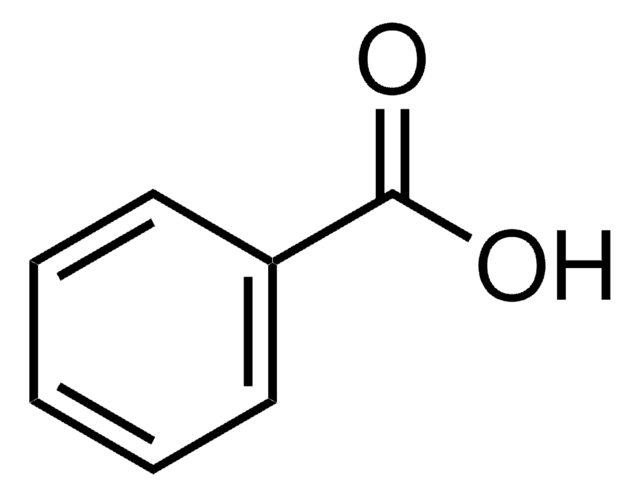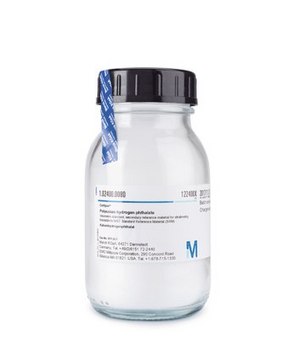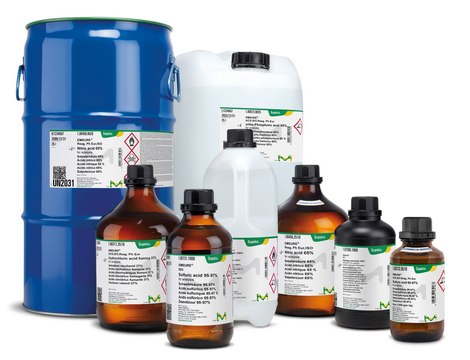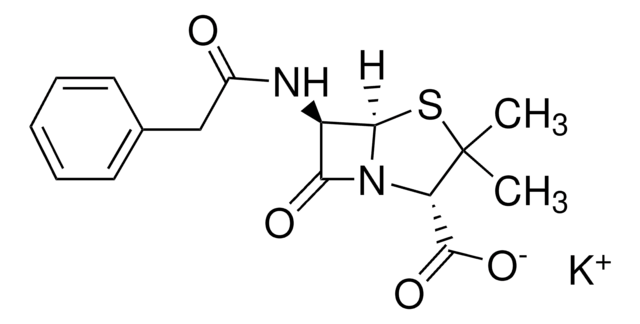推荐产品
等级
analytical standard
蒸汽密度
4.21 (vs air)
蒸汽压
10 mmHg ( 132 °C)
CofA
current certificate can be downloaded
自燃温度
1061 °F
包装
ampule of 1000 mg
技术
HPLC: suitable
gas chromatography (GC): suitable
沸点
249 °C (lit.)
mp
121-125 °C (lit.)
溶解性
water: soluble (2.9 g/l at 25 °C)
密度
1.32 g/cm3 at 20 °C
应用
cleaning products
cosmetics
flavors and fragrances
food and beverages
personal care
包装形式
neat
储存温度
room temp
SMILES字符串
OC(=O)c1ccccc1
InChI
1S/C7H6O2/c8-7(9)6-4-2-1-3-5-6/h1-5H,(H,8,9)
InChI key
WPYMKLBDIGXBTP-UHFFFAOYSA-N
正在寻找类似产品? 访问 产品对比指南
一般描述
苯甲酸是食品饮料工业中常用的防腐剂。可自然发生于数种植物 和动物,也可由微生物产生。在许多次级代谢产物的生物合成中,它可以作为一种中间化合物而得到应用。
应用
有关合适仪器技术的更多信息,请参考产品的分析证书。如需进一步支持,请联系技术服务。
警示用语:
Danger
危险声明
危险分类
Eye Dam. 1 - Skin Irrit. 2 - STOT RE 1 Inhalation
靶器官
Lungs
储存分类代码
6.1C - Combustible acute toxic Cat.3 / toxic compounds or compounds which causing chronic effects
WGK
WGK 1
闪点(°F)
Not applicable
闪点(°C)
Not applicable
Benzoic acid and its derivatives as naturally occurring compounds in foods and as additives: Uses, exposure, and controversy
Olmo DA, et al.
Critical Reviews in Food Science and Nutrition, 57, 3084-3103 (2017)
Yeast response and tolerance to benzoic acid involves the Gcn4-and Stp1-regulated multidrug/multixenobiotic resistance transporter Tpo1
Godinho.PC, et al.
Applied Microbiology and Biotechnology, 1-14 (2017)
S Nacht et al.
Journal of the American Academy of Dermatology, 4(1), 31-37 (1981-01-01)
The transepidermal penetration and metabolic disposition of 14C-benzoyl peroxide were assessed in vitro (excised human skin) and in vivo (rhesus monkey). In vitro, the benzoyl peroxide penetrated into the skin, through the stratum corneum or the follicular openings, or both
Renbo Wei et al.
Macromolecular rapid communications, 34(4), 330-334 (2013-01-03)
A new approach is developed to fabricate highly oriented mono-domain LCE nano/microstructures through micro-molding in capillaries. Gratings and microwires as two typical examples are fabricated and characterized by polarizing optical microscopy, optical microscopy, and scanning electron microscopy. The gratings with
G C Tremblay et al.
Pharmacology & therapeutics, 60(1), 63-90 (1993-10-01)
Detoxification of sodium benzoate by elimination as a conjugate with glycine, a nonessential amino acid, provides a pathway for the disposal of waste nitrogen. Since 1979, sodium benzoate has been widely used in the therapeutic regimen to combat ammonia toxicity
我们的科学家团队拥有各种研究领域经验,包括生命科学、材料科学、化学合成、色谱、分析及许多其他领域.
联系技术服务部门





